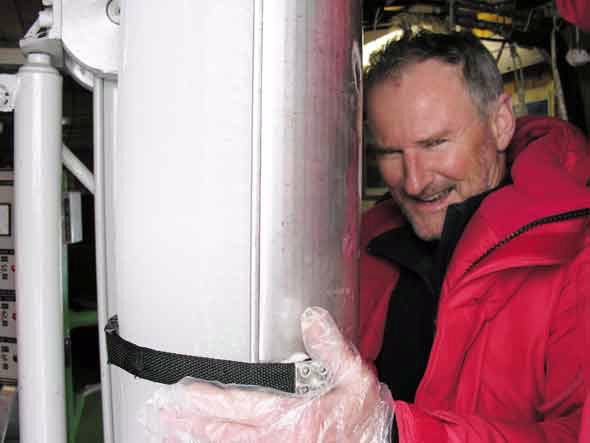 |
| Andrew Smith with the 20 cm ice core extracted from a site on the East Antarctic Ice Sheet |
ANSTO environmental research scientist Andrew Smith is a co-author on a paper published today in Nature Geoscience reporting research that has elucidated the mechanism of carbon-climate feedback.
In the paper, the researchers have verified and quantified the relationship between the Earth’s land biosphere and changes in temperature and provided evidence that temperature impacts the cycling of carbon between land, ocean and the atmosphere. See CSIRO Media Release.
Smith was part of the team that travelled to the Dome Summit South (DSS) site in Antarctica, a small ice cap on the edges of the main East Antarctic Ice Sheet in November 2005 to collect ice cores for dating. He was the Chief Investigator for the project which provided the logistics and transport for the expedition.
A high resolution ice core used in the study was collected by the ANSTO-led expedition team.
“We were camped for the month at Dome Summit South at an elevation of 1380 metres above sea level, and located about 110 km from the Australian base, Casey. We were ‘stranded’ there with no vehicles,” said Smith.
There were four others in the team besides Smith, including Adam Sarbutt from ANSTO.
The ice core was removed using the Antarctic Division’s thermal drill which was refurbished at ANSTO prior to the expedition.
“At a diameter of nearly 20 cm, it was a much larger core than the usual 8 cm diameter,” said Smith.
Additionally, ANSTO helped with the dating of the core and with two other cores that were used indirectly in the paper.
The polar ice contains air bubbles that preserve gases from the atmosphere, including CO2.
ANSTO’s involvement was taking measurements of the radiocarbon CO2 bomb pulse – the doubling of the radioactivity of 14C of atmospheric CO2 that occurred during the 1950-1960s as a consequence of above-ground nuclear testing.
The bomb pulse turns out to be a powerful means of ‘tuning’ the CSIRO model of air diffusion and trapping in the firn, the porous region of compacting snow overlying the impervious ice, that was used in the analysis,” explained Smith.
These processes give rise to a spread of ages for each of the atmospheric gases trapped in the air bubbles in the ice.
“It is crucial to be able to ‘deconvolute’ or run this process backwards in order to retrieve the atmospheric signal from the ice core record,” explained Smith.
Measurement of the radiocarbon bomb pulse in these samples was only possible because of ANSTO’s special capability for making precise 14C measurements on samples that contain just a few micrograms of carbon at ANSTO's Centre for Accelerator Science.
The research was led by CSIRO. Other collaborating institutions included the University of Melbourne, the British Antarctic Survey, the University of East Anglia, the Australian Antarctica Division, the University of Tasmania and ANSTO.
Smith has been travelling to Antarctica and other locations for more than 20 years collecting ice cores that can be used as environmental tracers and chronometers. He is an expert in using 14C on ultra-small samples and 7Be and 10Be in polar ice.
doi:10.1038/ngeo2769
Published: 26/07/2016

